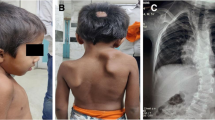Abstract
Introduction
Our knowledge and understanding of vertebral fusion, defined and eponymously known as Klippel–Feil syndrome in the early 1900s, have a long history. This uncommon finding has been identified as early as 500 B.C. in an Egyptian mummy. Many more examples of spinal vertebra fusion have been described by Greek historians and recovered by archeologists demonstrating this entity’s rich history.
Conclusions
Klippel–Feil syndrome is a rare skeletal anomaly characterized by abnormal fusion of two or more vertebrae. With the advent of newer molecular technology and genetic discoveries, we now have a better understanding of the etiology and possible pathogenesis of this disease.









Similar content being viewed by others
References
Klippel M, Feil A (1912) Un cas d’absence des vertèbres cervicales, cage thoracique remon- tant jusqu’à la base du crâne. Nouvelle Icon- ographie de la Salpêtrière 25:223–250
Gorlin RJ Cohen M, Hennekam R (2001) Syndromes of the head and neck. N.p.: Oxford University Press 4th ed., pP. 1142
Mohamed JY, Faqeih E, Alsiddiky A, Alshammari MJ, Ibrahim NA, Alkuraya FS (2013) Mutations in MEOX1, encoding mesenchyme homeobox 1, cause Klippel-Feil anomaly. Am J Hum Genet 92:157–161
Tutankhamun shows his face 80 years after tomb is opened (2016). The Telegraph. London.http://www.telegraph.co.uk/news/worldnews/africaandindianocean/egypt/1408698/Tutankhamun-shows-his-face-80-years-after-tomb-is-opened.html. Accessed 24 Jun
Boyer RS, Rodin EA, Grey TC, Connolly RC (2003) The skull and cervical spine radiographs of Tutankhamen: a critical appraisal. AJNR Am J Neuroradiol 24:1142–1147
Conception Hélène Beaulieu (2012) Historical aspects In: Regroupement francophone international Klippel-Feil. http://www.klippel-feil.info/histoire.html
Discovery (2009) Oldest known paralyzed human discovered. http://archive.is/VgLA
Gorman J (2012–12-17). Ancient bones that tell a story of compassion (17 December 2012, New York edition, D1). The New York Times.
Giuffra V, Vitiello A, Giusiani S, Fornaciari A, Caramella D, Villari N, Fornaciari G (2009) Rheumatoid arthritis, Klippel-Feil syndrome and Pott’s disease in cardinal Carlo de’ Medici (1595-1666). Clin Exp Rheumatol 4:594–602
González-Reimers E, Mas-Pascual A, Arnay-De-La-Rosa M, Velasco-Vásquez J, Jiménez-Gómez MC (2001) Klippel-Feil syndrome in the prehispanic population of El Hierro (Canary Islands). Ann Rheum Dis 60:173–173
Pizzutillo PD (1983) Klippel-Feil syndrome. In: The cervical spine. The Cervical Spine Research Society, Lippincott, Philadelphia, pp. 174–188
Fernandes T, Costa C (2007) Klippel-Feil syndrome with other associated anomalies in a medieval Portuguese skeleton (13th-15th century). J Anat 211:681–685
Martin ME (1954) A Klippel-Feil syndrome in the artistic works of William Blake. Bull Hist Med 28:270
Herman MJ, Pizzutillo PD (2012) The cervical spine. Lippincott, Philadelphia, pp. 398–399
Clarke RA, Catalan G, Diwan AD, Kearsley JH (1998) Heterogeneity in Klippel-Feil syndrome: a new classification. Pediatr Radiol 28:967–974
Samartzis DD, Herman J, Lubicky JP, Shen FH (2006) Classification of congenitally fused cervical patterns in Klippel-Feil patients: epidemiology and role in the development of cervical spine-related symptoms. Spine 31:798–804
David KM, Thorogood PV, Stevens JM, Crockard HA (1999) The dysmorphic cervical spine in Klippel-Feil syndrome: interpretations from developmental biology. Neurosurg Focus 6(6):E3
Gunderson CH, Greenspan RH, Glaser GH, et al. (1967) The Klippel-Feil syndrome: genetic and clinical reevaluation of cervical fusion. Medicine (Baltimore) 46:491–512
Karaca E, Yuregir OO, Bozdogan ST, et al. (2015) Rare variants in the notch signaling pathway describe a novel type of autosomal recessive Klippel–Feil syndrome. Am J Med Genet A 167:2795–2799
McGaughran JM, Oates A, Donnai D, Read AP, Tassabehji M (2003) Mutations in PAX1 may be associated with Klippel–Feil syndrome. Eur J Hum Genet 11:468–474
Author information
Authors and Affiliations
Corresponding author
Ethics declarations
Conflict of interest
The authors have no conflicts of interest.
Rights and permissions
About this article
Cite this article
Saker, E., Loukas, M., Oskouian, R.J. et al. The intriguing history of vertebral fusion anomalies: the Klippel–Feil syndrome. Childs Nerv Syst 32, 1599–1602 (2016). https://doi.org/10.1007/s00381-016-3173-4
Received:
Accepted:
Published:
Issue Date:
DOI: https://doi.org/10.1007/s00381-016-3173-4




